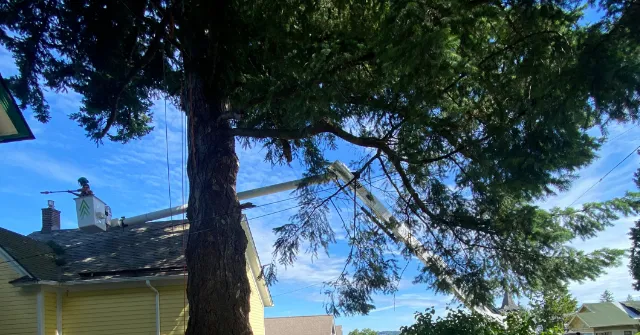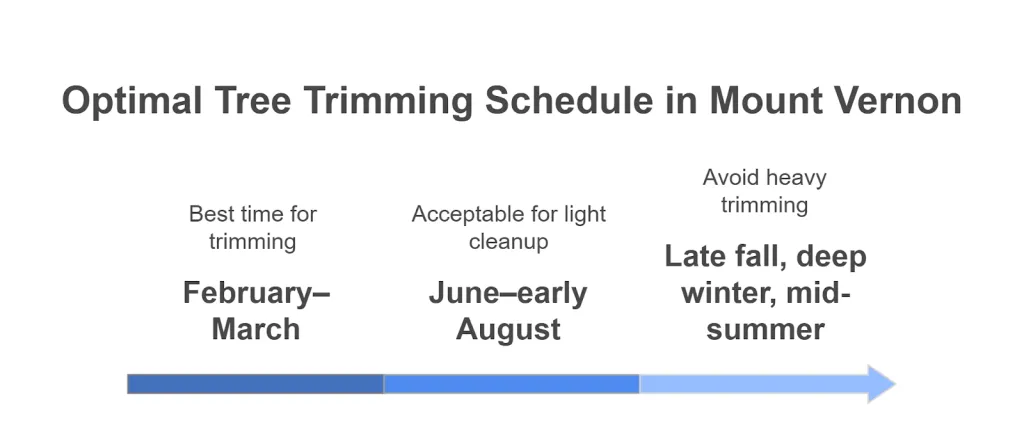
ISA-Certified Arborists
Bellingham, WA 98225
Mount Vernon, WA 98273
Open 24/7
Financing Available
ISA-Certified Arborists

Bellingham, WA 98225
Mount Vernon, WA 98273

July 16, 2025
If you live in Mount Vernon and you’ve got a tree pushing too close to your roof or leaning too hard toward your neighbor’s place, chances are you’re wondering when to take care of it. And yeah-when you trim makes a difference. Do it too early, too late, or during the wrong weather stretch, and you can cause more harm than good.
What follows here isn’t theory-it’s what we see work out in real backyards and farms across Skagit County. No fluff. Just straightforward advice from the field.
Trees aren’t static. They shift with the seasons. Prune while they’re dormant and they’ll usually heal up quick as soon as spring growth kicks in. But trim at the wrong time and you could stress the tree or invite disease, especially in our damp climate.

Around here, February into early March is usually the sweet spot. Why?
If it’s a fruit tree, a big-leaf maple, or one of the more common flowering trees in Mount Vernon, this is usually the right time to get in there.
| Tree Type | Best Time to Trim | Local Notes |
| Maple, Birch | Late spring or summer | Trimming too early causes sap to bleed everywhere |
| Oaks, Elms | Late fall to early spring | Avoid spring/summer to dodge disease risk |
| Spring bloomers | Right after flowering | You’ll lose next year’s blooms if you cut too soon |
| Apple, Pear | Late winter or early spring | Light summer cleanup is fine |
| Evergreens & Conifers | Late winter | Avoid while they’re pushing new growth |
There are times when summer trimming makes sense. You just have to be selective.
But don’t go crazy. Mid-summer heat and drought can slow healing.
| Task | Safe in Summer? | What to Keep in Mind |
| Remove deadwood | Yes | Good anytime |
| Light thinning | Yes | Do it early in the morning or on cooler days |
| Heavy reshaping | No | Save it for winter |
| Storm cleanup | Yes | Always a priority |
| Fruit tree cuts | Sometimes | Depends on variety and condition |
Fall’s a mixed bag. You’ll get decent weather some years, but late-season pruning can backfire.
If you do trim in the fall, do it early and keep it light.
This isn’t theory-it’s what we’ve seen play out season after season:
Here in Mount Vernon, you can’t rely solely on the calendar. Here’s what throws the usual rules out the window:
What matters is reading the tree and watching the weather. Not just flipping to a certain page on the calendar.
These are the red flags that tell you to pause before making that first cut.
Homeowners who don’t end up calling us in a panic usually follow a few good habits:
Consistency keeps trees healthier than big cleanups done too late.
It’s not always the obvious stuff that leads to trouble. Look for:
If something feels off, it usually is.
Trimming isn’t the final step. A little follow-up goes a long way.
For big cuts, peek at them a couple weeks later. If they’re darkening or showing signs of dieback, call someone.
That depends. Here’s a rough guide based on what we see:
A little attention each season beats an expensive cleanup later.
Late winter’s probably the best time, especially around here. Just don’t do it during a deep freeze.
Not always. Just keep it minimal and avoid hot, dry spells.
Deadwood, crossed limbs, or any branch scraping your siding is a solid clue.
Right after the blooms drop. Earlier, and you’re chopping next year’s show.
Absolutely. Never take more than a quarter of the canopy in one go.
Sharp bypass pruners, loppers, a clean pruning saw, and basic safety gear. Keep everything disinfected between trees.
Look, Mount Vernon weather keeps us on our toes. No two years are the same. The best thing you can do is stay flexible. Trim in late winter when you can, clean up when it’s safe in summer, and always walk your yard with a sharp eye.
And if you’re ever unsure? Ask someone who’s climbed a few trees around here. We’re happy to point you in the right direction.
At Earthworks Tree Service, we are more than just tree care specialists—we are stewards of the natural beauty that defines our community. We offer free estimates for all of our tree services.
What Our Clients Say
Our experience with Earthworks was terrific ... Because of Brandon's expertise, he was able to save our [over] 100-year-old oak. The tree [we] were married under! We will ONLY use Earthworks tree service!
Earthworks saved our orchard! We had two consultations with Earthworks regrading our fruit trees. As novices, we'd made several missteps that were affecting the health of our trees. Christopher was very knowledgable and helpful
These guys rock! Brandon and his team are knowledgeable, professional, and responsible. They are nice guys and do a fabulous job. We will definitely call them again when needing any tree removal or trimming, as well as planting services.
Amazing company. They have a quick turnaround time, and the quality of work is worth every penny. They were also very fast, which was a pleasant surprise! I will definitely hire them again in the future.
I recently had the pleasure of working with Earthworks, and I can't recommend them enough! They provided expert advice and showed impressive restraint by advising us against cutting down some of our healthy trees, demonstrating their commitment to preserving our landscape.
Fast, efficient, nice. More than one person has told me that they were surprised how neatly and quickly the latest job was done. Used them a few times over the years. Never a problem.
We offer a comprehensive range of tree services, including tree removal, trimming, pruning, stump grinding, tree health assessments, emergency tree services, and land clearing. Whether you need routine maintenance or have an urgent tree-related issue, we've got you covered.
A tree may need to be removed if it is diseased or dying, damaging property, posing a safety hazard due to structural issues, or obstructing essential sunlight or views. Our ISA Certified Arborists can assess the tree's condition and recommend the appropriate action.
Tree pruning is essential for maintaining the health, shape, and safety of your trees. Most trees benefit from pruning every 3-5 years, but fast-growing species may require more frequent attention based on specific landscape goals.
In a tree emergency, contact Earthworks Tree Service for our 24/7 Emergency Tree Removal service, which includes rapid response, safe removal of hazardous trees, risk assessment, post-removal cleanup, and coordination with local authorities if necessary.
Yes, we offer a satisfaction guarantee on most of our services and provide warranties on specific services like tree removal and stump grinding; details are discussed during the consultation to ensure you’re fully informed.
Trust our arborists and tree care experts to rejuvenate your property. Please use the form on this page to schedule your free estimate. Or call (360) 994-1211 to speak with us directly.
Fill out the form below, and we'll get back to you.